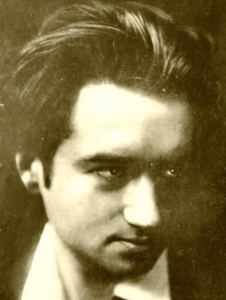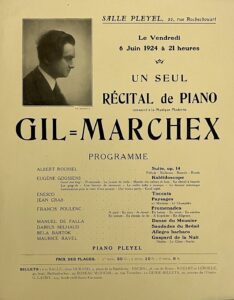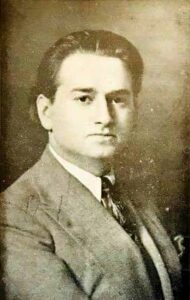 Not all pianists of distinction left behind significant recorded legacies, which can adversely impact the degree to which their importance is recognized today. One such artist was the French musician Henri Gil-Marchex, a fascinating individual whose varied activities extended far beyond the piano: he was a pianist, composer, and arranger, but also an author, enthno-musicologist, reporter, race-car driver, radio documentary producer, and theatre critic.
Not all pianists of distinction left behind significant recorded legacies, which can adversely impact the degree to which their importance is recognized today. One such artist was the French musician Henri Gil-Marchex, a fascinating individual whose varied activities extended far beyond the piano: he was a pianist, composer, and arranger, but also an author, enthno-musicologist, reporter, race-car driver, radio documentary producer, and theatre critic.
He was born Henri Gilles on December 16, 1892 (French musicologist Frédéric Gaussin has obtained proof that his birth year was not 1894 as widely published). He changed his name when he married Jeanne-Alice Marcheix in 1918, adapting the spelling of both their names to Gil-Marchex. His parents both came from prosperous and respected families, and this extended well down the line: Henri was the great-great-great-great-grandson of Denis Diderot (1713-1784), the French philosopher, art critic, writer, and the co-founder, chief editor, and contributor of L’Encyclopedie.

Gil-Marchex was under Fauré’s direction when he entered the Paris Conservatoire at the age of 9, studying piano with Louis Diémer, in whose class he won a Premier Prix in 1911. His musical activities were quite prodigious: he traveled more kilometres worldwide as a touring artist than Alfred Cortot (though the latter gave more concerts), playing throughout Europe, Egypt, the USSR, Indonesia, the Philippines, and North & South America. He was the first French pianist to perform and gave conferences in Japan, undertaking four tours between 1925 and 1937, an experience that had a significant influence on his own music-making (as one of his compositions below will reveal). He was an early champion of Ravel’s music and the esteem was mutual: the composer called him “one of my best friends and best performers” and Gil-Marchex was the only performer whom Ravel permitted to arrange one of his works (he wrote a paraphrase on the fox-trot of L’Enfant et les sortilèges which he premiered in Tokyo in 1925); he was also the pianist in the first performance of Tzigane, in London on April 26, 1924 with violinist Jelly d’Aranyi, to whom the work was dedicated. He too had works dedicated to him by, among others, Auric and Roussel.
 His vast repertoire ran the gamut from 18th century harpsichordists to music composed by his peers (as well as his own) and was the only French pianist who at the time would publicly perform Schonberg’s Klavierstücke, Prokofiev’s Visions fugitives, Szymanowski’s Etudes Op.33, and the major works by Bartók and Stravinsky. However, for all his activity and his long life – he died in 1970 – he only recorded in 1927: 42 sides of 78rpm discs for the Columbia label set down between October and December of that year. Most of these were rejected or destroyed, leaving but a handful that were published, almost completely out of print by 1930-31, and rarely issued since: the first time I ever saw his name was a recent Sakuraphon CD produced in Japan (sold out – previously available online here). There is also one brief 1954 broadcast that has been found and published, which is shared on this page.
His vast repertoire ran the gamut from 18th century harpsichordists to music composed by his peers (as well as his own) and was the only French pianist who at the time would publicly perform Schonberg’s Klavierstücke, Prokofiev’s Visions fugitives, Szymanowski’s Etudes Op.33, and the major works by Bartók and Stravinsky. However, for all his activity and his long life – he died in 1970 – he only recorded in 1927: 42 sides of 78rpm discs for the Columbia label set down between October and December of that year. Most of these were rejected or destroyed, leaving but a handful that were published, almost completely out of print by 1930-31, and rarely issued since: the first time I ever saw his name was a recent Sakuraphon CD produced in Japan (sold out – previously available online here). There is also one brief 1954 broadcast that has been found and published, which is shared on this page.
Below, a selection of his recordings, including two rejected Columbia 78s unearthed and uploaded by Monsieur Gaussin, to whom pianophiles are surely grateful.
First, a fine account of Couperin’s Le Bavolet Flottant, elegantly played with crisp articulation, gorgeous tone in every note, and a steady rhythm without any boxy rigidity.
More ‘claveciniste’ composers on this ravishing disc set down on December 14, 1927: Scarlatti’s Sonata in C Major K.159/L.104 and the Menuets I & II from Rameau’s Suite in G Major. Both are played with exquisite craftsmanship: glistening tone, deft definition in each note, and wonderful use of the pedal.
Next, an October 15, 1927 disc that was not approved for release, a pressing of which was fortunately discovered by Monsieur Gaussin. Listening to Gil-Marchex’s glorious playing, one wonders why it would have been rejected (perhaps the slight pitch variation near the end was an issue). The first of the two works on this disc is Chopin’s Prelude en F Major Op.28 No.23, which features absolutely gorgeous tone that glistens gloriously, his nuancing and timing wonderfully synchronized – a master class in under a minute! This is followed by Schubert’s Moment musical in F Minor Op.94 No.3, with the same beauty of tone and marvellously transparent textures that enable Gil-Marchex to clearly highlight the harmonic shifts in the work.
Another rejected October 15, 1927 disc courtesy of Gaussin features two works by Chopin, the first Prelude – the C Major Op.28 No.1 – followed by the first Etude – the C Major Op.10 No.1. Both are of astonishing beauty and elegantly crafted, glistening in the treble and full-bodied and resonant in the bass – perhaps the almost imperceptible smudges of a couple of notes in the Etude led to the disc being rejected but being able to hear these readings now is, these minor flaws aside, revelatory.
Next we move into the music of the pianist’s contemporaries: an October 17, 1927 disc of Debussy’s Prelude Minstrels, capturing the joyful nature of the work with his marvellous buoyant touch, full-bodied tone in every note, varied articulation, and playful timing.
Another Debussy performance by the artist recorded on October 17, 1927 is this sultry, sinewy reading of La Puerta del vino. What full-bodied tone, sumptuous nuancing, impeccable balance of voicing, and masterful pedal effects.
Finally, a June 9, 1954 broadcast recording of the 62-year-old Gil-Marchex – by this point already out of the limelight – playing his own Quatre Images du vieux Japon, complete with announcements from the French radio transmission. Two of these works were unpublished and being played for the first time in this broadcast. The artist’s pianistic mastery was undiminished here, as evidenced by his sumptuous tonal colours, masterfully coordinated pedal effects, and transparent textures, all of which capture the evocative moods of each piece.
Let us hope that more recordings of Henri Gil-Marchex – be they rejected 78s or broadcast performances – will be located and made available. Most definitely a pianist to remember!
Many thanks to Frédéric Gaussin, without whose generosity in sharing invaluable information, audio files, and images this feature would not have been possible